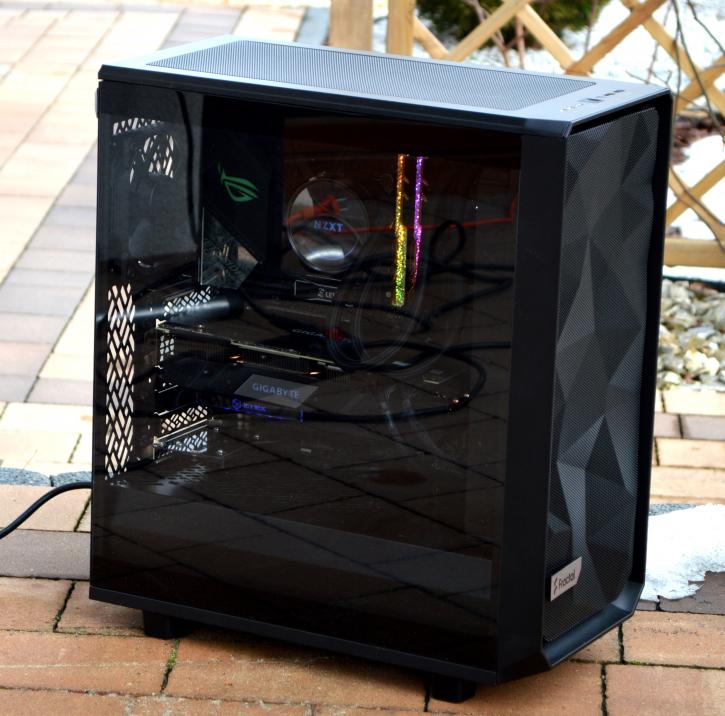Final Words & Conclusion
Final Words & Conclusion
Let's wrap it up. The Fractal Design MESHIFY 2 COMPACT is a nice mid-tower chassis. It’s an evolution of the FD Meshify C done the proper way. The mesh design is a good choice, because it allows good airflow, with the noise still well under control.
The internal layout is typical, with the PSU installed at the bottom of the case. The installation process is rather straightforward, and you shouldn’t have any major issues here (provided your PSU is no longer than 165 mm, with the HDD cage is installed, or up to 200 mm without it). The build quality is really good, and the new side panel mechanism works great. This time, you also get three fans and not two like in the previous model. Two 140 mm units at the front and one 120 mm fan should be enough for the typical air-cooled system.
Features
There’s enough space for up to 360 mm long GPUs (when the front fan is not installed, with it it’s 341 mm), 169 mm tall CPU coolers, and 165 mm long PSUs (and even 200 mm ones with the HDD cage removed). This is enough for typical builds. Storage-wise you'll have plenty of options in the form of two dedicated mounts for SSDs and four for 3.5”/2.5” drives (but you only get two sets of mounting brackets). The liquid cooling capacity is ok, and you can install a 360 mm rad on the front of the case, a 240 mm one at the top, and a 120 mm one at the back (and even a 120 mm rad at the bottom with HDD cage removed). The I/O panel has a very standard set of two USB 3.0 ports, audio jacks, and power + reset buttons, but you can also find a USB 3.1 Type-C connector there – it’s a very nice addition.
Aesthetics
Looks are always a matter of personal preference. The design of the new MESHIFY 2 COMPACT is nice. Not as classic as the Define series, but I’m sure it already has its fans. There is “only” one tempered glass panel (it’s even possible to get a version with a solid left panel), but this should be enough to show off your gear if you want to. Three colour variants are available – black (reviewed here), grey, and white, so everyone should be able to find the best match for their system.
Performance
Thanks to the mesh design, the temperatures are very good, especially for the CPU. The noise levels are also quite surprisingly good. With decent airflow, the fans don’t need to spin as much as in chassis with a closed design.
The Verdict
The Fractal Design MESHIFY 2 COMPACT is an attractive, compact (as it should be) mid-tower chassis focused on airflow with its mesh design. It’s an evolution of the Meshify C done the right way. The side panels have a better mounting system, and you get three (unfortunately not the PWM, but 3-pin) instead of two fans. Overall, the compatibility is broader this time, with more space for the components. The maximum motherboard form factor that you can use is standard ATX, and you can install 360 + 240 +120 mm water cooling radiators and a 169 mm air cooler. Moving on to storage, the case fits up to eight drives (four 2.5” + four 2.5 or 3.5” bays, but only two mounting brackets are provided per each option). The installation went pretty well: the cable management system is good, but the PSU space (without removing the HDD cage) was tight for what we use in our test system (a Seasonic Prime Titanium Ultra 850W). The build quality is also good, especially considering the budget. Speaking of which, the price is 109.99 USD/99.99-108.99 EUR, so we can grant the “Recommended” award here, for the features provided. As usual with Fractal Design products, you get what you pay for (although this case is still about 30 EUR more than its predecessor). Well, if there is anything to add at all, I’d say that a fan hub would have come in handy. It’s a nice thing to have, especially for systems with a small number of fan headers on the motherboard. Additionally, the fans are not the PWM ones (it's not a big issue), there's no RGB (for some it's a drawback), and no vertical GPU mounting is possible. Also, while it’s still compact, the case is bigger than the previous model, at 424 x 210 x 475 mm (L x W x H) vs 395 x 212 x 440mm, so it’s 42.3l vs 36.84. That’s almost 15% more volume. Not a biggie (pun intended), and you can’t expect a range of new features without sacrificing anything (this time the size) in return, right?
- Sign up to receive a notification when we publish a new article
- Or go back to Guru3D's front page



